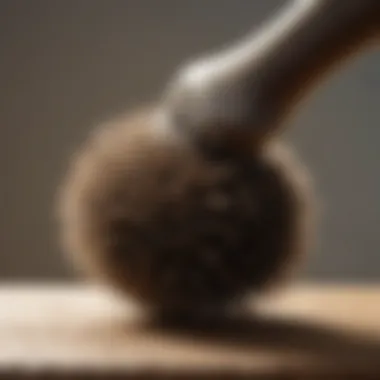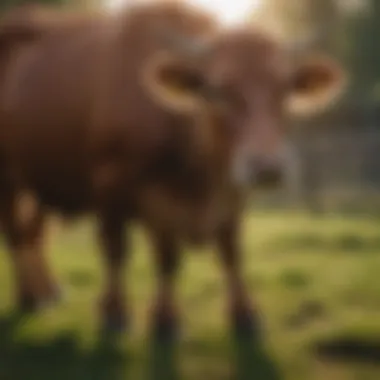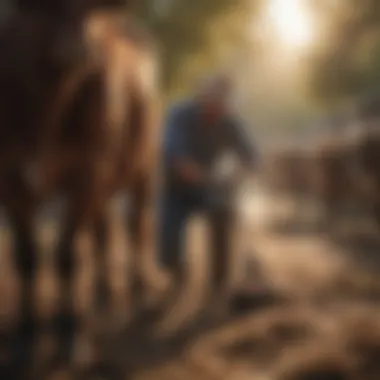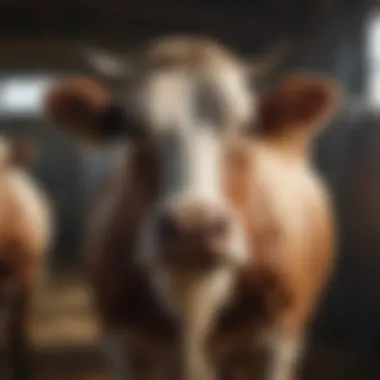The Vital Role of Cattle Grooming Brushes


Intro
Cattle grooming brushes are not just simple tools for cleaning animals; they are essential components of effective livestock management. Grooming affects the overall health and welfare of cattle. Proper grooming practices can impact an animal's comfort levels, skin condition, and even their social interactions within the herd. By delving into the significance of these brushes, one can understand their role in maintaining optimal animal health and preventing many diseases.
Through this article, we will explore various types of grooming brushes available, their specific benefits, and best practices for usage. Moreover, we will discuss how grooming contributes to physical well-being—boosting circulation, preventing skin irritations, and enhancing the effectiveness of veterinary checks. This comprehensive overview will equip farmers and livestock caretakers with knowledge beneficial for implementing effective grooming routines, thus improving the productivity and overall quality of their cattle.
Intro to Cattle Grooming
Cattle grooming is a fundamental practice in livestock management. Yet, it often goes unnoticed, overshadowed by more visible aspects like feeding, health checks, and breeding. Grooming does not merely enhance the animals' appearances; it plays a critical role in their overall well-being. Understanding this practice is vital for effective cattle care.
Understanding Grooming as a Practice
Grooming involves various actions: brushing, washing, and inspecting the animal's coat and skin. These tasks are essential for identifying any potential issues, such as skin diseases or parasites. Equally important, grooming fosters a bond between the animal and handler. This interaction can lead to reduced stress for the cattle, making them more manageable during routine handling.
Moreover, grooming helps to stimulate blood circulation, which can influence the animal's overall vitality. It also encourages the natural oils to distribute across the coat, thereby maintaining the skin and hair in optimal health.
Benefits of Regular Grooming
The benefits of regular grooming are manifold, affecting both the physical and psychological health of the cattle.
- Disease Prevention: Regular grooming allows for early detection of skin problems, like lesions, mites, or infections. Addressing these issues promptly can prevent larger health crises.
- Improved Comfort: A well-groomed animal is a more comfortable animal. The removal of dirt and debris reduces irritation, fostering a better living environment.
- Fostering Relationship: Regular handling reinforces trust between the animal and caretaker. This can lead to better overall behavior during handling or medical procedures.
In summary, grooming is not just a cosmetic practice but a necessary component of good livestock management. This section sets the stage for a deeper exploration of the tools and techniques essential for effective grooming.
Types of Cattle Grooming Brushes
Understanding the different types of cattle grooming brushes is essential for effective livestock management. Each type of brush serves a distinct purpose, catering to the unique needs of cattle grooming. Selecting the appropriate brush can lead to improved coat health, better hygiene, and enhanced animal comfort. This section will explore the primary types of grooming brushes used in cattle care, detailing their specific functions and advantages in the livestock management process.
Body Brushes
Design Features
Body brushes are fundamental tools in cattle grooming. They typically feature a large, flat surface for efficient coverage of the animal's body. Most body brushes are made with bristles that range in firmness. Stiffer bristles can effectively remove dirt and loose hair while softer bristles can enhance the shine of the coat. The most common design includes a sturdy handle that allows for ease of use, even in larger breeds. These features make body brushes a beneficial choice for overall grooming routines.
The key characteristic that sets body brushes apart is their ability to stimulate the skin and promote natural oil production. This unique quality not only contributes to coat health but also enhances the animal's overall well-being during grooming sessions.
Applications in Grooming
The application of body brushes in grooming routines goes beyond just cleaning. They help in loosening dirt and debris embedded in the coat, making subsequent grooming steps more effective. Regular use of body brushes can improve circulation and further keep the coat healthy.
Additionally, body brushes are effective in removing dander and dead skin, which helps in preventing skin issues. The versatility of body brushes, coupled with their ease of use, results in routine grooming becoming smoother and more efficient.
Mane and Tail Brushes
Materials Used
Mane and tail brushes are specialized for the more delicate areas of a cattle's grooming routine. These brushes often use softer bristles and materials tailored to handle the finer hair of the mane and tail. They are typically constructed with synthetic bristles or natural materials like boar hair, balancing gentleness and effectiveness.
The primary advantage of using specific materials is reduced risk of hair breakage or pulling. This ensures that grooming is both comfortable for the animal and effective in maintaining the health of mane and tail hair.
Techniques for Use
Grooming techniques for mane and tail brushes emphasize gentle handling. Start from the tips and gradually work your way up. This approach minimizes discomfort and stress for the animal.


Using a detangling spray can also ease the process and reduce pulling. The technique is crucial because it influences the overall grooming experience and the condition of the mane and tail. Proper techniques contribute to a negative free grooming environment for the cattle, enhancing the bond between the handler and the animals.
Hoof Brushes
Importance of Hoof Care
Hoof health is a vital aspect of overall cattle welfare. Hoof brushes specifically address the cleanliness and health of the hooves. Using these brushes regularly helps to prevent infections and diseases such as hoof rot. Clean hooves can lead to better mobility and productivity among cattle, making hoof care a priority in livestock management.
The importance of hoof care cannot be overstated. Regular brushing encourages hoof inspection, allowing for early detection of issues and ensuring timely intervention.
Proper Usage Guidelines
When using hoof brushes, it is important to follow certain guidelines to achieve the best results. Start by picking out dirt and debris with a hoof pick before brushing. This practice prevents damaging the brush and ensures a thorough cleaning.
Also, tailor your brushing technique based on the condition of each hoof. This cautious approach maintains the integrity of the hooves and optimizes hygiene. Understanding how to use hoof brushes properly is crucial for maintaining a well-managed herd.
Zoom Groom Brushes
Unique Design Benefits
Zoom groom brushes have a unique design that makes them popular among livestock handlers. Their rubber bristles effectively remove loose hair while also providing a massaging effect on the skin. This promotes circulation and enhances the animal’s comfort during grooming. This brush type is often easy to clean and can be used both wet and dry, adding to its versatility.
The design benefits also include durability. Rubber materials withstand wear and tear and can last significantly longer than brushes made from natural fibers.
Effectiveness in Grooming
The effectiveness of zoom groom brushes is notable in their ability to provide an enjoyable grooming experience. They attract loose hair and dirt efficiently, while the soft bristles work to keep the skin healthy. For animals that are sensitive to traditional brushes, zoom groom brushes often prove to be a suitable alternative.
Selecting the Right Grooming Brush
Selecting the right grooming brush is vital for effective livestock management. Proper grooming not only enhances the cattle's appearance but significantly contributes to their health. The right brush serves various purposes, including removing dirt, debris, and loose hair. It also stimulates the skin, promoting blood circulation. Understanding the factors involved in selecting a suitable brush can improve the overall grooming process, leading to healthier cattle and more efficient management practices.
Material Considerations
Natural vs Synthetic Materials
When choosing grooming brushes, material plays a critical role. Natural materials, such as bristle or wood, are popular among livestock managers for their gentle touch. They are often soft and flexible, making them ideal for sensitive areas on cattle. On the other hand, synthetic materials offer durability that natural brushes may lack. Synthetic brushes are likely to resist wear, making them a practical choice for everyday use. Natural brushes can excel in comfort, but synthetic options can provide longevity, appealing to those looking for cost-efficiency in the long run.
Durability Factors
Durability is an essential aspect of selecting grooming brushes. A durable brush withstands daily use and exposure to the elements. Brushes made with high-quality materials tend to last longer, reducing the need for frequent replacements. Additionally, durable brushes maintain their effectiveness over time, ensuring consistent grooming quality. While cost may be higher for more durable options, they ultimately save money through longevity. One should weigh initial costs against potential long-term savings when choosing brushes for cattle grooming.
Size and Shape
Impacts on Grooming Effectiveness
The size and shape of grooming brushes significantly impact their effectiveness. Larger brushes cover more surface area, making them efficient for general grooming tasks. Conversely, smaller brushes provide precision for areas requiring more care, like the face or legs. An appropriately sized brush can reduce grooming time and ensure that every part of the animal is reached thoroughly. The shape of the brush also influences how easily it can navigate tight spaces or around body contours, which contributes to the overall grooming experience.
Choices Based on Cattle Size
Different cattle breeds vary in size, leading to a need for customized grooming tools. For smaller cattle, using smaller and lighter brushes ensures they are comfortable during grooming. Larger breeds may require bigger and firmer brushes to effectively tackle their thicker coats. Choosing the right brush based on cattle size optimizes the grooming process and ensures that the animals receive the care they need. Understanding the specific requirements for various breeds will enhance the effectiveness of grooming sessions.
Brush Softness and Firmness
Skin Sensitivity Considerations


Cattle, like humans, can have varying skin sensitivities. The softness or firmness of a grooming brush can affect how comfortable the process is for the animal. Soft brushes are ideal for sensitive skin or areas susceptible to irritation. For more robust regions, firmer brushes can provide the necessary pressure to remove dirt without causing discomfort. Being aware of an individual animal's skin sensitivity is crucial to maintaining a positive grooming experience and ultimately their health.
Selecting Based on Breed
Each breed can exhibit different coat textures, which influence the type of grooming brush that should be used. For instance, long-haired breeds may benefit from brushes designed to detangle without causing harm. Alternatively, short-haired breeds might require brushes that effectively remove loose hair. By ensuring the right brush is selected based on the breed, one can achieve optimal results in grooming sessions. This tailored approach also enhances the relationship between caretaker and animal, fostering a sense of trust during the grooming process.
Techniques for Effective Grooming
Grooming cattle is not merely a routine task; it serves multiple essential purposes that enhance both the health of the animals and the efficiency of farm management. Effective grooming techniques ensure that livestock remains clean, healthy, and comfortable. Proper methods can prevent issues related to skin conditions and promote better circulation, which is vital for optimal animal growth.
Basic Grooming Procedures
Step-by-Step Grooming Process
The step-by-step grooming process is a pragmatic approach that outlines the tasks needed to keep cattle looking and feeling their best. This method involves a systematic sequence that includes brushing, inspecting for injuries, and cleaning hooves. Each step is crucial; neglecting any can lead to health problems.
A key characteristic of this process is the emphasis on thoroughness. Beginning with brushing, the process works from head to tail, removing dirt and loose hair. Inspection follows, allowing caretakers to spot any abnormalities early. By incorporating this method, farmers can improve not only hygiene but also cattle welfare.
The unique feature of this structured approach is its comprehensive nature. Rather than merely polishing the exterior, it intertwines health checks that can prevent more severe issues. Benefits include reducing the risk of skin infections and ensuring that the animals are comfortable, thus enhancing their productivity.
Frequency of Grooming Sessions
The frequency of grooming sessions directly impacts the overall well-being of cattle. Maintaining a consistent grooming schedule is vital. Regular sessions can help remove dirt and parasites that could harm the animals. The key characteristic of frequent grooming is the minimization of stress, both for the animals and the handlers.
It is ideal to groom cattle at least once a week, though more frequent sessions are beneficial during molting or when cattle are housed indoors. This regularity in grooming enhances skin health and ensures that cattle remain calm and less prone to behavioral issues.
Unique to this aspect is the adaptability of the grooming schedule to the specific needs of the herd. Weather conditions, housing setups, and the individual health of the animals can dictate adjustments. While daily grooming might not be necessary, a consistent routine fosters a positive environment and promotes overall health.
Grooming for Health Maintenance
Preventing Skin Conditions
One of the main advantages of grooming includes the prevention of skin conditions. By regularly brushing cattle, farmers can significantly reduce the prevalence of skin irritations and infections. Grooming removes debris and promotes air circulation, reducing the likelihood of conditions like dermatitis.
The preventive aspect of grooming is essential; it allows for early detection of problems, leading to timely intervention. Many cattle farmers find this beneficial, as it cuts down on veterinary costs and improves animal welfare simultaneously. It is a proactive approach to health care.
Unique to this method is the use of appropriate brushes designed for sensitive skin. Choosing the right brush and technique helps avoid causing pain or discomfort. Adopting good grooming practices ensures cattle remain healthy and reduces the potential for serious health complications.
Enhancing Circulation
Enhancing circulation is another significant benefit of effective grooming. When grooming is done correctly, it stimulates blood flow which is essential for maintaining the overall health of the animals. This is particularly important in young and growing cattle, as good circulation helps in nutrient distribution and muscle development.
The advantage of focusing on circulation through grooming is its dual role; not only does it promote physical health, but it also serves to relax the cattle. Many farmers notice that animals groomed regularly tend to exhibit calmer behavior.
What makes enhancing circulation via grooming unique is its non-invasive nature. Unlike other health interventions, grooming is simple and can be easily integrated into daily routines. It offers a practical way to improve health outcomes without additional stress on the cattle or their handlers.
Common Mistakes in Grooming
Grooming cattle is an essential part of livestock management, but many proprietors can easily slip into common pitfalls that compromise the process. Understanding these mistakes is crucial, as they can affect the health and well-being of the animals, as well as the efficiency of the grooming routine. Addressing these issues leads to better animal welfare and productivity.
Using Inappropriate Brushes
Choosing the right brushes for cattle grooming is paramount. Many individuals might rely on generic or unsuitable brushes without considering the specific needs of the animal. For instance, using body brushes meant for other animals can lead to skin irritation or inadequate cleaning. Cattle have unique coat types and skin sensitivities. Selecting brushes designed specifically for cattle ensures effective grooming without harming the animal. Observing the texture and size of brushes can also lead to better results. Ultimately, the right brush contributes to a smoother grooming process and a healthier coat.
Over-Grooming Issues


While grooming is beneficial, there can be a critical point where too much grooming becomes detrimental. Over-grooming can lead to skin abrasions, irritation, and even stress in the animal. It is crucial to monitor the frequency and intensity of grooming sessions. Ideally, grooming should complement the animal's natural shedding cycle rather than disrupt it. Keeping a schedule that aligns with the needs of each animal is important. Animals can signal discomfort, so attention to their behavior during grooming is essential.
Neglecting Hoof Care
Hoof care is often overlooked but is equally vital to the overall grooming routine. Neglecting this aspect can lead to serious health problems like laminitis or other hoof diseases. Properly maintaining hooves can help prevent infections and ensure that cattle remain mobile and comfortable. Regular checks should be integrated into the grooming schedule. It is advisable to clean and inspect the hooves along with the coat to provide comprehensive care. Proper tools like hoof picks should be used to maintain overall hoof hygiene.
"Effective grooming requires awareness of both the tools and methods used. The mistakes made here can significantly affect animal health and performance."
Addressing these common mistakes can enhance the grooming process, contribute to healthier animals, and improve animal management overall. Recognizing the importance of each component is essential for any individual involved in livestock care.
Maintaining and Caring for Grooming Brushes
Cattle grooming brushes are essential tools in the effective management of livestock, particularly in maintaining animal health and hygiene. However, the performance of these tools significantly depends on how well they are maintained and cared for. Proper upkeep prolongs the life of the brushes and ensures they provide optimal grooming results. Understanding the processes of cleaning and storing grooming brushes can greatly enhance their effectiveness and longevity, benefiting both the animal and the handler.
Cleaning Procedures
Cleaning grooming brushes is crucial to prevent the buildup of dirt, hair, and bacteria. Neglecting this task can lead to skin irritations or infections in cattle. Regular cleaning routines should include the following steps:
- Remove Hair and Debris: Use a comb or another brush to remove hair from the bristles after each use. This helps maintain the brush's efficiency.
- Wash Brushes: Submerge the brush in a mixture of warm water and a mild detergent, allowing it to soak for several minutes. This helps dissolve dirt and debris.
- Scrub the Bristles: Using a soft cloth or sponge, gently scrub the bristles to ensure thorough cleaning. Pay attention to the base of the bristles, where dirt accumulates.
- Rinse and Dry: Rinse the brush under clean water to remove all soap residue. Allow the brush to air-dry completely in a clean, dry area away from direct sunlight to prevent warping of materials.
Regular cleaning not only maintains brush effectiveness but also supports the overall health of the cattle being groomed.
Storage Tips
Proper storage of grooming brushes is as important as the cleaning process. Appropriate storage practices contribute to maintaining their shape and condition, ensuring they remain effective for grooming. Consider these storage tips:
- Keep Brushes Dry: Ensure brushes are completely dry before storing them. Moisture can lead to mildew growth and degrade brush materials over time.
- Use Dedicated Storage: Designate a specific area or container for grooming brushes; this prevents them from mixing with other tools that may cause damage or contamination.
- Avoid Direct Sunlight: Store brushes away from direct sunlight, as exposure can weaken the bristles and compromise their functionality.
- Regular Inspections: Periodically check stored brushes for any signs of wear or damage. Addressing issues early can prevent further deterioration.
Maintaining and caring for grooming brushes is essential in livestock management. By establishing a routine for cleaning and proper storage, farmers can ensure that these tools remain effective, contributing significantly to the health and welfare of their cattle.
The Business Aspect of Grooming Brushes
Understanding the business aspect of grooming brushes is essential for livestock management. This section focuses on how various trends and innovations shape the market, influencing what farmers and ranchers choose for their operations. Selecting the right products not only impacts animal welfare but also affects the bottom line of a farming business. As such, the business of grooming brushes should not be overlooked by those involved in agriculture.
Market Trends and Innovations
In recent years, the market for grooming brushes has seen significant changes. One major trend is the increasing demand for eco-friendly products. Farmers are becoming more conscious about sustainability. Hence, grooming brushes made from biodegradable or recyclable materials are gaining popularity.
Moreover, technological advancements have led to the creation of innovative brushes. Some brushes come with ergonomic designs that reduce strain during prolonged use. Others introduce features like self-cleaning mechanisms or interchangeable heads, enhancing efficiency. Following these trends can provide farmers with a competitive edge.
Recent studies show an upward trajectory in sales for grooming products, particularly those that emphasize functionality and environmental responsibility. Investing time to understand these trends could lead to better decision-making.
Selecting Quality Suppliers
Choosing the right suppliers for grooming brushes is a crucial element in maintaining quality and efficiency. Several aspects should guide this selection process.
- Reputation and Reviews: Research supplier backgrounds and read reviews from others who have purchased their products. A reputable supplier is more likely to offer quality items.
- Product Range: Suppliers who provide a wide variety of brushes can be more helpful. This diversity allows you to select options that best fit your needs.
- Customer Support: Ensure that the supplier offers reliable customer support. This factor can be essential, especially when facing issues with products.
- Pricing: Compare costs among different suppliers to find the best value. However, do not compromise quality just to save costs.
- Warranty and Return Policies: A good supplier should have a reasonable warranty and return policy. This flexibility provides assurance in case the products do not meet expectations.
Ultimately, the choices made regarding suppliers can have long-term effects on livestock management practices. Investing wisely in grooming brushes and understanding the market is vital for effective livestock management.
Culmination and Future Directions
The discussion of cattle grooming brushes in livestock management reveals not only their critical role in maintaining the health of the animals but also the broader implications for sustainable farming practices. The remedial benefits of grooming are numerous, from preventing skin infections to enhancing blood circulation in cattle. It becomes evident that regular grooming establishes a routine that farmers can depend upon for better livestock management.
The Role of Grooming in Sustainable Practices
Grooming goes beyond aesthetic appeal; it is integral to animal welfare. Regular grooming reduces the use of chemicals in combating parasites and skin ailments. It indirectly lowers the overall cost of maintaining cattle by promoting natural health solutions. Moreover, the practice can contribute positively to the environment. Cattle that are well-groomed tend to be healthier and require less veterinary intervention, thereby reducing the carbon footprint associated with livestock production. The integration of grooming brushes into daily routines promotes animal comfort and enhances cattle productivity.
Innovations in Grooming Products
The market for grooming products is continuously evolving. Recent innovations focus on enhancing the functionality and effectiveness of grooming brushes. For instance, some modern brushes are designed with ergonomic handles to ease strain during prolonged use. Others incorporate advanced materials that are gentler on the skin and more durable. As consumer awareness of animal welfare grows, the demand for high-quality grooming tools has risen. Manufacturers are responding by creating brushes with antimicrobial properties and biodegradable materials. This ensures that farmers can maintain their cattle’s hygiene without contributing to environmental degradation.







